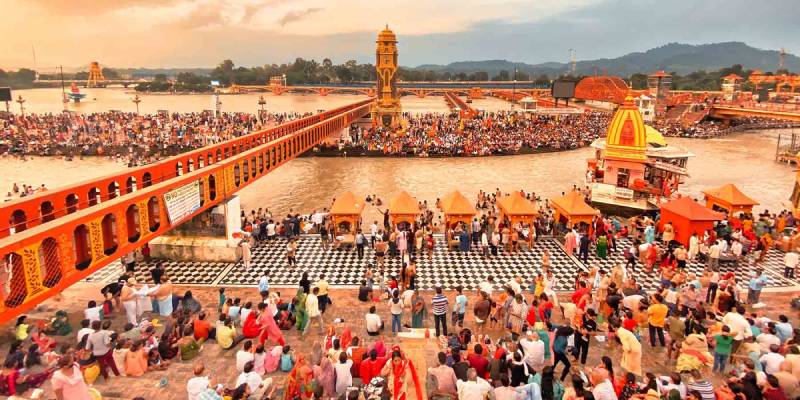The Kumbh Mela is the world’s largest religious festival, drawing millions of Hindu pilgrims to the banks of India’s sacred river. A testament to faith, devotion and spiritual awakening, this extraordinary event draws seekers from across the country and abroad.
What is Kumbh Mela?
The Kumbh Mela is a deeply revered Hindu pilgrimage rooted in ancient mythology and centered on faith in the purifying powers of the holy river. Pilgrims take a ritual bath in its waters, believing that doing so will cleanse them of their sins and pave the way to spiritual liberation (moksha).
The festival is held in four holy cities: Prayagraj (formerly Allahabad), Haridwar, Nashik and Ujjain. Each place is connected to a sacred river – the Ganges, Godavari and Shipra – from which, according to Hindu legend, the divine nectar (Amrit) flows.
Each of these four cities holds a full Kumbh Mela every 12 years and a half (ardh) festival every six years.
This year’s festival is the Maha (Grand) Kumbh Mela, a special event held every 144 years. This rare gathering will take on added significance as millions of devotees, saints and spiritual leaders gather to take part in sacred rituals and seek divine blessings.
What does Kumbh Mela mean?
The term “Kumbh Mela” means “Festival of the Pitcher” in Sanskrit.
In Hindu mythology, “kumbh” refers to the pitcher or pot containing the nectar of immortality, whereas “mela” refers to a fair or assembly.
Hindu scriptures relate the narrative of the Samudra Manthan, in which gods and demons churned the ocean of milk in search of the nectar of immortality.
According to traditions, four drops of this nectar arrived on the sites where the Kumbh Mela is now held, making them sacred.
Why Do People Attend Kumbh Mela?
Kumbh Mela attracts millions of devotees, including ascetics and spiritual seekers, as well as families and international visitors, making it one of the world’s greatest festivals of religion.
While significantly rooted in Hindu traditions, the event captivates people of many backgrounds who come to witness its grandeur and cultural diversity.
The fundamental reason for attending festival is spiritual purification and regeneration. Bathing in sacred waters during the festival is thought to cleanse sins, interrupt the cycle of rebirth (samsara), and bring one closer to moksha (liberation).
Aside from the rituals of religion, the festival is a transforming experience in which pilgrims can strengthen their faith, seek counsel from great saints and sages, and connect with a large spiritual community. For many, this voyage is a once-in-a-lifetime experience, providing an unparalleled opportunity to immerse themselves in Hindu philosophy and devotion.
How long does Kumbh Mela last?
Kumbh Mela is a weeks-long spiritual gathering that normally lasts 45 days. The 2025 Kumbh Mela is scheduled to take place from January 13 to February 26.
The event has a religious schedule, with essential bathing days (shahi snans) marking the most important occasions. The festival finishes with the last royal bath, which is considered the most fortunate time for spiritual purification.
The exact dates and duration of each Kumbh Mela are chosen by Hindu astrologers and religious leaders using heavenly alignments and traditional scriptures.
What happens during the Kumbh Mela?
The Kumbh Mela is a vibrant mix of religious rituals, spiritual practices and cultural celebrations that draws millions of devotees.
The highlight of the festival is the Shahi Snan (Royal Baths), where a group of revered sadhus, especially the Naga sadhus known for their ash-covered bodies austere lifestyle—lead the ceremonial dips in the sacred river. These baths are said to cleanse sins and bring about spiritual enlightenment.
Beyond the bathing rituals, the festival is a centre for spiritual conversations, devout songs, religious processions and cultural performances. Pilgrims pray, listen to sermons from learned saints and take part in meditation and yoga sessions.
Numerous religious groups set up temporary camps, providing free food, shelter and spiritual guidance, creating a unique atmosphere of faith, learning and service to the community.
How many people attend the Kumbh Mela?
The festival is one of the largest mass gatherings of people in the world. Hundreds of millions of people visit during the festival.
The Maha Kumbh Mela, to be held in Prayagraj in 2025, is expected to attract a record 400 million pilgrims over its 45-day period. Pilgrims and tourists line the 12-kilometre river bank in a breathtaking display of faith and loyalty.
Authorities employ the following methods to estimate crowd size:
- Security cameras to monitor crowd density in real time
- Manual counts of people at entrances and exits
- Drones to analyze crowd size from the air
- Mobile phone data to assess the number of active users in the area
Despite these efforts, it remains difficult to accurately count each and every pilgrim. This is especially true for long-term residents like the Kalpwasis, who stay for the entire festival period and may be counted multiple times.
How will the Kumbh Mela be held?
Organising this festival is an extraordinary logistical challenge, requiring months of preparation to accommodate millions of visitors. Authorities are transforming the festival site into a temporary megacity, complete with the necessary infrastructure, public services and safety measures.
For the 2025 Maha Kumbh Mela, the site will cover 4,000 hectares (40 km²) and include:
- 160,000 tents to house pilgrims
- 40,000 police and security personnel to ensure security
- 15,000 cleaners to maintain hygiene
- 99 parking spaces for over 500,000 vehicles
- 30 floating bridges for smooth crossing of rivers
- 67,000 street lights to illuminate the festival site
- 150,000 toilets for hygiene purposes
- 25,000 bins to dispose of waste and promote cleanliness
From healthcare and waste disposal to traffic management, authorities are introducing hi-tech solutions like AI-based crowd monitoring, drones and mobile tracking in terms of security to ensure the smooth running of the event.





